door lock MERCEDES-BENZ S CLASS 2019 Owners Manual
[x] Cancel search | Manufacturer: MERCEDES-BENZ, Model Year: 2019, Model line: S CLASS, Model: MERCEDES-BENZ S CLASS 2019Pages: 578, PDF Size: 23.31 MB
Page 15 of 578
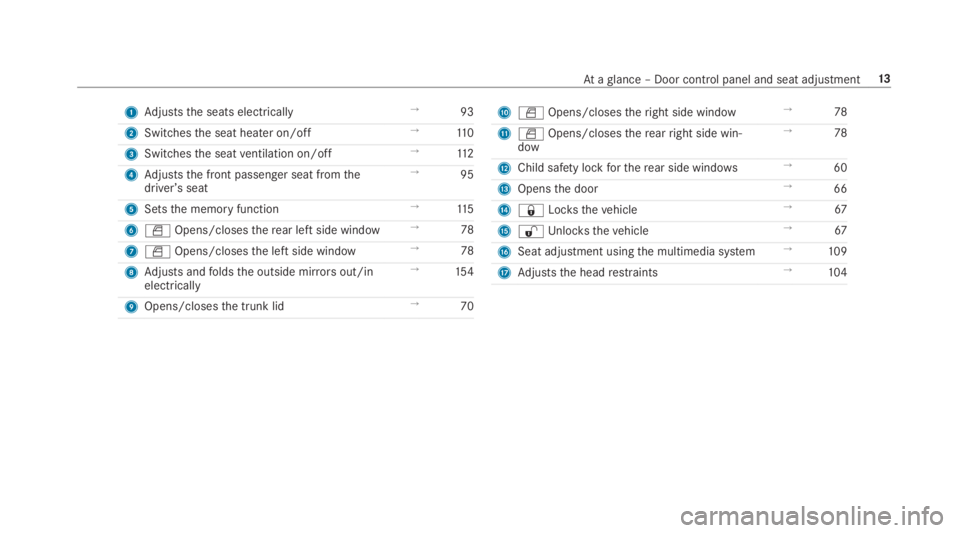
1Adjuststhe seats electrically→93
2Switchesthe seat heater on/off→11 0
3Switchesthe seatventilation on/off→11 2
4Adjuststhe front passenger seat fromthedriver’sseat
→95
5Setsthe memory function→11 5
6�bOpens/closestherear left side window→78
7�bOpens/closesthe left side window→78
8Adjusts andfoldsthe outside mirrorsout/inelectrically
→154
9Opens/closesthe trunk lid→70
A�bOpens/closestheright side window→78
B�bOpens/closestherearright side win‐dow
→78
CChild safety lockfortherear side windows→60
DOpensthe door→66
E�7Locksthevehicle→67
F�6Unlocksthevehicle→67
GSeat adjustment usingthe multimedia system→109
HAdjuststhe headrestraints→104
Ataglance – Door control panel and seat adjustment13
Page 37 of 578
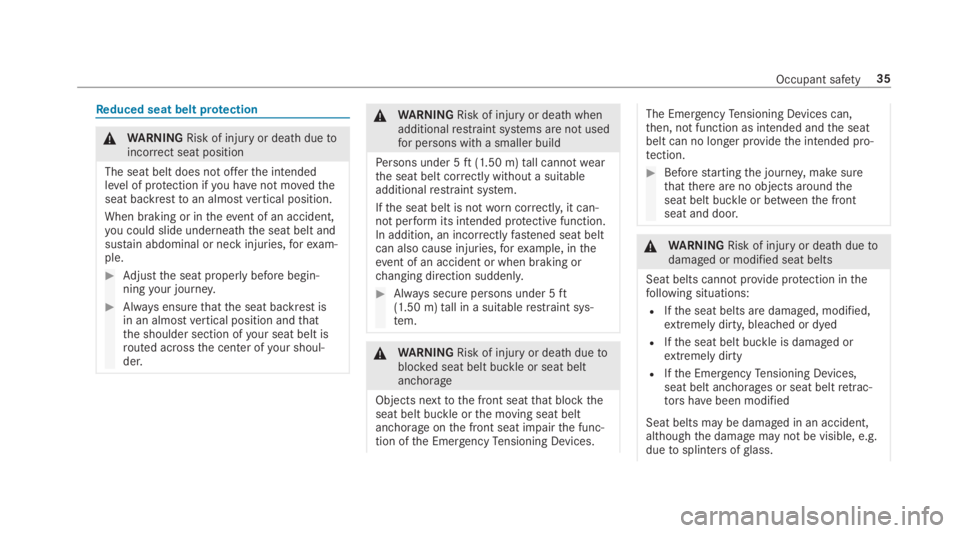
Reduced seat belt protection
&WARNINGRisk of injuryor death duetoincorrect seat position
The seat belt does not offerthe intendedlevel of protection ifyou havenot movedtheseat backresttoan almostvertical position.
When braking or intheevent of an accident,you could slide underneaththe seat belt andsustain abdominal or neck injuries,forexam‐ple.
#Adjustthe seat properlybefore begin‐ningyour journey.
#Always ensurethatthe seat backrest isin an almostvertical position andthatthe shoulder section ofyour seat belt isrouted acrossthe center ofyour shoul‐der.
&WARNINGRisk of injuryor death whenadditionalrestraint systems are not usedfor persons with a smaller build
Persons under 5ft(1.50 m)tall cannotwearthe seat belt correctly without a suitableadditionalrestraint system.
Ifthe seat belt is notworncorrectly, it can‐not performits intended protective function.In addition, an incorrectlyfastened seat beltcan also cause injuries,forexample, intheevent of an accident or when braking orchanging direction suddenly.
#Always secure persons under 5ft(1.50 m)tall in a suitablerestraint sys‐tem.
&WARNINGRisk of injuryor death duetoblocked seat belt buckle or seat beltanchorage
Objects nexttothe front seatthat blocktheseat belt buckle orthe moving seat beltanchorage onthe front seat impairthe func‐tion ofthe EmergencyTensioning Devices.
The EmergencyTensioning Devices can,then, not function as intended andthe seatbelt can no longer providethe intended pro‐tection.
#Beforestartingthe journey,make surethatthere are no objects aroundtheseat belt buckle or betweenthe frontseat and door.
&WARNINGRisk of injuryor death duetodamaged or modified seat belts
Seat belts cannotprovide protection inthefollowing situations:
RIfthe seat belts are damaged, modified,extremelydirty, bleached or dyed
RIfthe seat belt buckle is damaged orextremelydirty
RIfthe EmergencyTensioning Devices,seat belt anchorages or seat beltretrac‐torshavebeen modified
Seat belts may be damaged in an accident,althoughthe damage may not be visible, e.g.duetosplinters ofglass.
Occupant safety35
Page 61 of 578
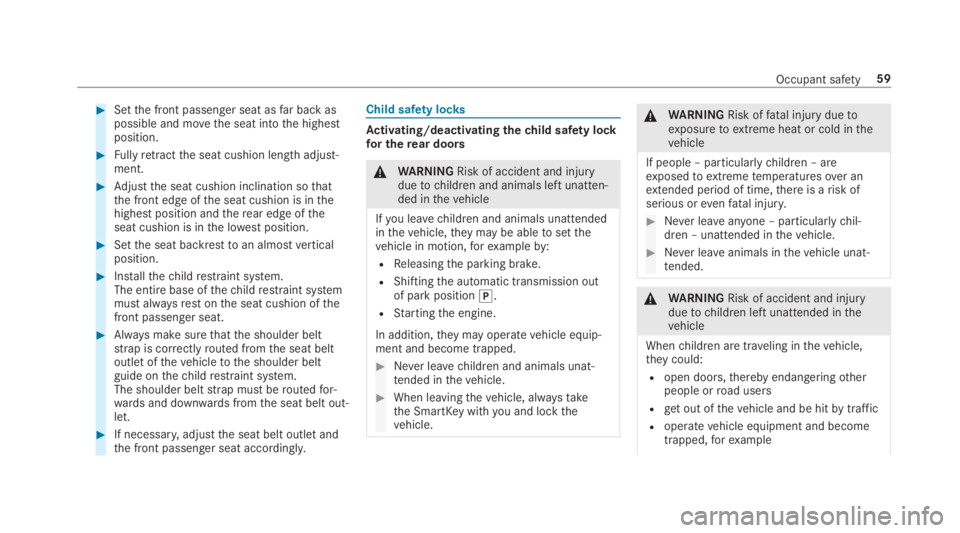
#Setthe front passenger seat asfar back aspossible and movethe seat intothe highestposition.
#Fullyretractthe seat cushion length adjust‐ment.
#Adjustthe seat cushion inclination sothatthe front edge ofthe seat cushion is inthehighest position andtherear edge oftheseat cushion is inthe lowestposition.
#Setthe seat backresttoan almostverticalposition.
#Installthechildrestraint system.The entire base ofthechildrestraint systemmust alwaysrestonthe seat cushion ofthefront passenger seat.
#Always make surethatthe shoulder beltstrap is correctlyrouted fromthe seat beltoutlet ofthevehicletothe shoulder beltguide onthechildrestraint system.The shoulder beltstrap must beroutedfor‐wards and downwards fromthe seat belt out‐let.
#If necessary,adjustthe seat belt outlet andthe front passenger seat accordingly.
Child safety locks
Activating/deactivating thechild safety lockfor therear doors
&WARNINGRisk of accident and injuryduetochildren and animals left unatten‐ded inthevehicle
Ifyou leavechildren and animals unattendedinthevehicle,theymay be abletosetthevehicle in motion,forexampleby:
RReleasingthe parking brake.
RShiftingthe automatic transmission outof park position�].
RStartingthe engine.
In addition,theymay operatevehicle equip‐ment and become trapped.
#Never leavechildren and animals unat‐tended inthevehicle.
#When leavingthevehicle, alwaystakethe SmartKeywithyou and lockthevehicle.
&WARNINGRisk offatal injury duetoexposuretoextreme heat or cold inthevehicle
If people – particularlychildren – areexposedtoextremetemperaturesover anextended period of time,there is arisk ofserious orevenfatal injury.
#Never leaveanyone – particularlychil‐dren – unattended inthevehicle.
#Never leaveanimals inthevehicle unat‐tended.
&WARNINGRisk of accident and injuryduetochildren left unattended inthevehicle
Whenchildren are traveling inthevehicle,theycould:
Ropen doors,thereby endangeringotherpeople orroad users
Rgetout ofthevehicle and be hitbytraffic
Roperatevehicle equipment and becometrapped,forexample
Occupant safety59
Page 62 of 578
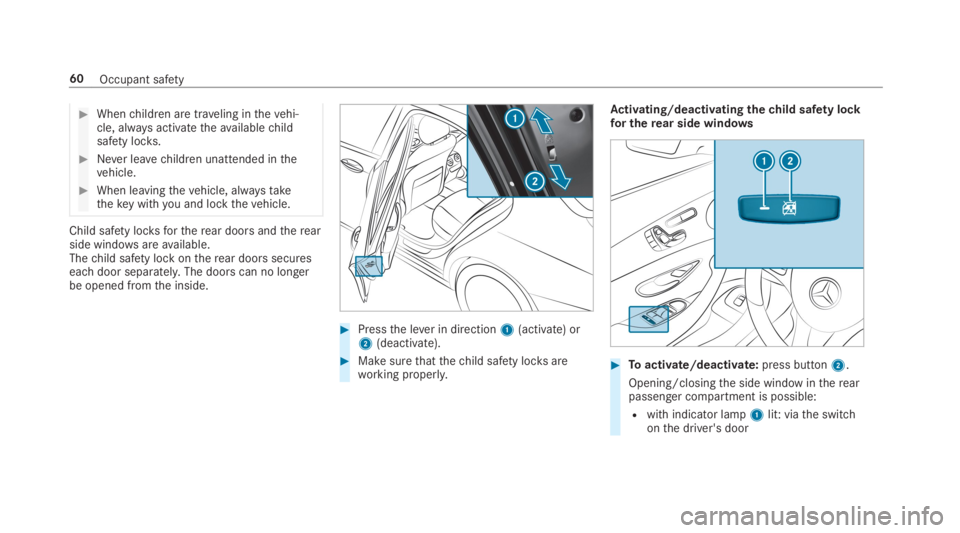
#Whenchildren are traveling inthevehi‐cle, always activatetheavailablechildsafety locks.
#Never leavechildren unattended inthevehicle.
#When leavingthevehicle, alwaystakethekey withyou and lockthevehicle.
Child safety locksfortherear doors andtherearside windowsareavailable.Thechild safety lock ontherear doors secureseach door separately.The doors can no longerbe opened fromthe inside.
#Pressthe lever in direction1(activate) or2(deactivate).
#Make surethatthechild safety locksareworking properly.
Activating/deactivating thechild safety lockfor therear side windows
#Toactivate/deactivate:press button2.
Opening/closingthe side window intherearpassenger compartment is possible:
Rwith indicator lamp1lit: viathe switchonthe driver's door
60Occupant safety
Page 63 of 578
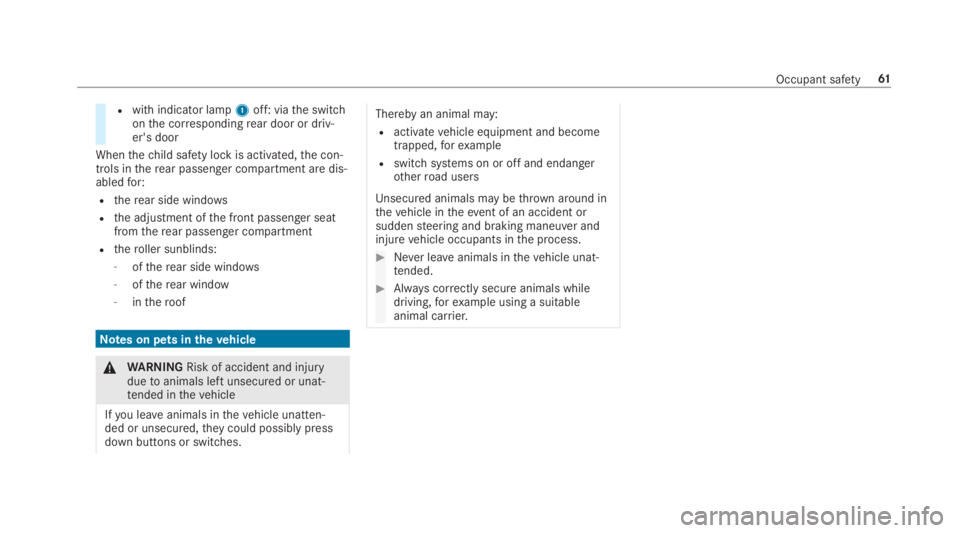
Rwith indicator lamp1off: viathe switchonthe correspondingrear door or driv‐er's door
Whenthechild safety lock is activated,the con‐trols intherear passenger compartment are dis‐abledfor:
Rtherear side windows
Rthe adjustment ofthe front passenger seatfromtherear passenger compartment
Rtheroller sunblinds:
-oftherear side windows
-oftherear window
-intheroof
Notes on pets inthevehicle
&WARNINGRisk of accident and injuryduetoanimals left unsecured or unat‐tended inthevehicle
Ifyou leaveanimals inthevehicle unatten‐ded or unsecured,theycould possibly pressdown buttons or switches.
Therebyan animal may:
Ractivatevehicle equipment and becometrapped,forexample
Rswitchsystems on or off and endangerotherroad users
Unsecured animals may bethrown around inthevehicle intheevent of an accident orsuddensteering and braking maneuver andinjurevehicle occupants inthe process.
#Never leaveanimals inthevehicle unat‐tended.
#Always correctly secureanimals whiledriving,forexample using a suitableanimal carrier.
Occupant safety61
Page 64 of 578
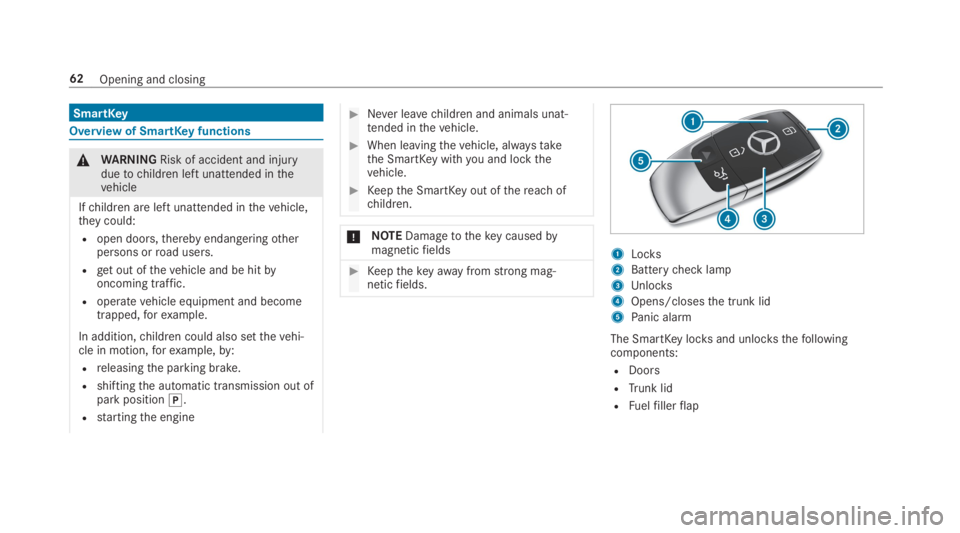
SmartKey
Overview of SmartKeyfunctions
&WARNINGRisk of accident and injuryduetochildren left unattended inthevehicle
Ifchildren are left unattended inthevehicle,theycould:
Ropen doors,thereby endangeringotherpersons orroad users.
Rget out ofthevehicle and be hitbyoncoming traffic.
Roperate vehicle equipment and becometrapped,forexample.
In addition,children could also setthevehi‐cle in motion,forexample,by:
Rreleasingthe parking brake.
Rshiftingthe automatic transmission out ofpark position�].
Rstartingthe engine
#Never leavechildren and animals unat‐tended inthevehicle.
#When leavingthevehicle, alwaystakethe SmartKeywithyou and lockthevehicle.
#Keepthe SmartKeyout ofthereach ofchildren.
*NOTEDamagetothekey causedbymagneticfields
#Keepthekeyawayfromstrong mag‐neticfields.
1Locks
2Batterycheck lamp
3Unlocks
4Opens/closesthe trunk lid
5Panic alarm
The SmartKey locksand unlocksthefollowingcomponents:
RDoors
RTrunk lid
RFuelfillerflap
62Opening and closing
Page 65 of 578
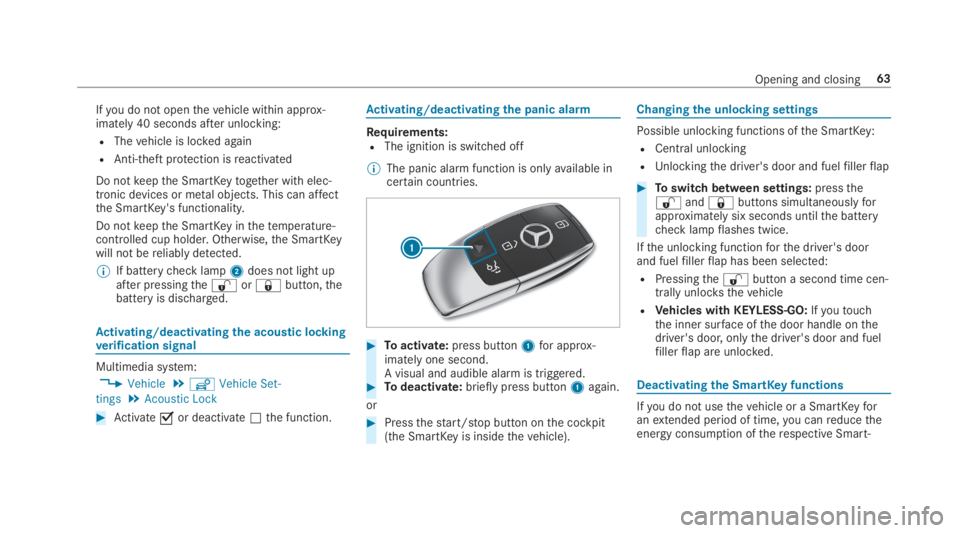
Ifyou do not openthevehicle within approx‐imately 40 seconds after unlocking:
RThevehicle is locked again
RAnti-theft protection isreactivated
Do notkeepthe SmartKeytogether with elec‐tronic devices or metal objects. This can affectthe SmartKey's functionality.
Do notkeepthe SmartKeyinthetemperature-controlled cup holder. Otherwise,the SmartKeywill not bereliably detected.
%If batterycheck lamp2does not light upafter pressingthe�6or�7button,thebattery is discharged.
Activating/deactivating the acoustic lockingverification signal
Multimedia system:
,Vehicle.îVehicle Set-
tings.Acoustic Lock
#Activate�sor deactivate�Sthe function.
Activating/deactivating the panic alarm
Requirements:RThe ignition is switched off
%The panic alarm function is onlyavailable incertain countries.
#Toactivate:press button1for approx‐imatelyone second.A visual and audible alarm is triggered.#Todeactivate:briefly press button1again.
or
#Pressthestart/stop button onthe cockpit(the SmartKeyis insidethevehicle).
Changingthe unlocking settings
Possible unlocking functions ofthe SmartKey:
RCentral unlocking
RUnlockingthe driver's door and fuelfillerflap
#Toswitch between settings:pressthe�6and�7buttons simultaneouslyforapproximately six seconds untilthe batterycheck lampflashes twice.
Ifthe unlocking functionforthe driver's doorand fuelfillerflap has been selected:
RPressingthe�6button a second time cen‐trally unlocksthevehicle
RVehicles with KEYLESS-GO:Ifyoutouchthe inner surface ofthe door handle onthedriver's door, onlythe driver's door and fuelfillerflap are unlocked.
Deactivatingthe SmartKeyfunctions
Ifyou do not usethevehicle or a SmartKey foranextended period of time,you canreducetheenergy consumption oftherespective Smart‐
Opening and closing63
Page 68 of 578
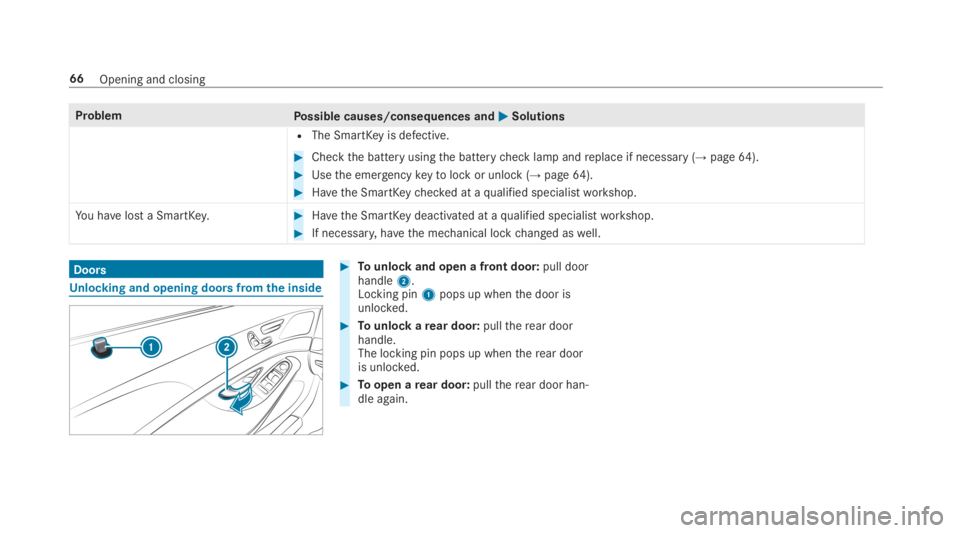
ProblemPossible causes/consequences and�P�PSolutions
RThe SmartKeyis defective.
#Checkthe battery usingthe batterycheck lamp andreplace if necessary (→page64).
#Usethe emergencykeytolock or unlock (→page64).
#Havethe SmartKeychecked at aqualified specialistworkshop.
You havelost a SmartKey.#Havethe SmartKeydeactivated at aqualified specialistworkshop.
#If necessary,havethe mechanical lockchanged aswell.
Doors
Unlocking and opening doors fromthe inside
#Tounlockand open a front door:pull doorhandle2.Locking pin1pops up whenthe door isunlocked.
#Tounlockarear door:pulltherear doorhandle.The locking pin pops up whentherear dooris unlocked.
#Toopen arear door:pulltherear door han‐dle again.
66Opening and closing
Page 69 of 578
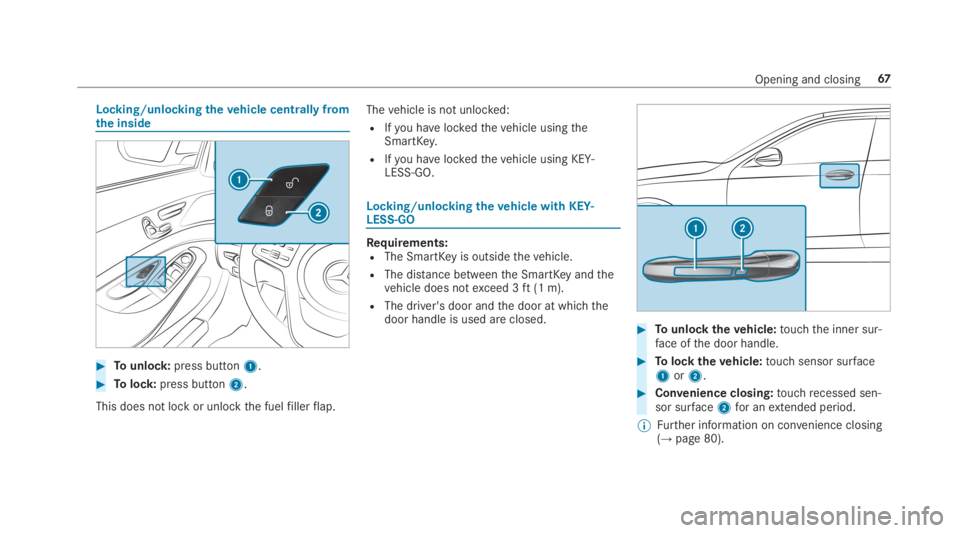
Locking/unlockingthevehicle centrally fromthe inside
#Tounlock:press button1.
#Tolock:press button2.
This does not lock or unlockthe fuelfillerflap.
Thevehicle is not unlocked:
RIfyou havelockedthevehicle usingtheSmartKey.
RIfyou havelockedthevehicle using KEY‐LESS-GO.
Locking/unlockingthevehicle with KEY‐LESS-GO
Requirements:RThe SmartKeyis outsidethevehicle.
RThe distance betweenthe SmartKeyandthevehicle does notexceed 3ft(1 m).
RThe driver's door andthe door at whichthedoor handle is used are closed.#Tounlockthevehicle:touchthe inner sur‐face ofthe door handle.
#Tolockthevehicle:touch sensor surface1or2.
#Convenience closing:touchrecessed sen‐sor surface2for anextended period.
%Further information on convenience closing(→page80).
Opening and closing67
Page 71 of 578
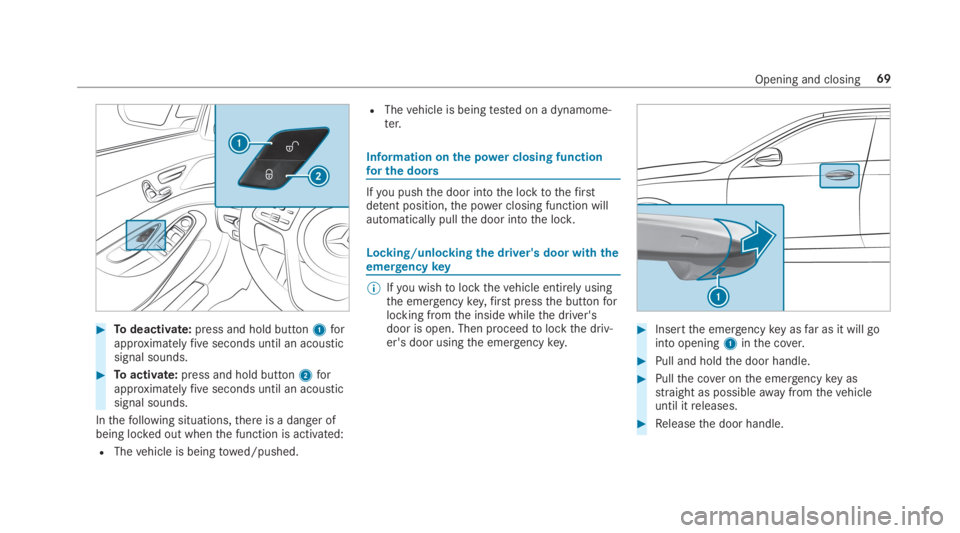
#Todeactivate:press and hold button1forapproximatelyfiveseconds until an acousticsignal sounds.
#Toactivate:press and hold button2forapproximatelyfiveseconds until an acousticsignal sounds.
Inthefollowing situations,there is a danger ofbeing locked out whenthe function is activated:
RThevehicle is beingtowed/pushed.
RThevehicle is beingtested on a dynamome‐ter.
Information onthe power closing functionfor the doors
Ifyou pushthe door intothe locktothefirstdetent position,the power closing function willautomatically pullthe door intothe lock.
Locking/unlockingthe driver's door withtheemergencykey
%Ifyou wishtolockthevehicle entirely usingthe emergencykey,first pressthe buttonforlocking fromthe inside whilethe driver'sdoor is open. Then proceedtolockthe driv‐er's door usingthe emergencykey.#Insertthe emergencykey asfar as it will gointo opening1inthe cover.
#Pull and holdthe door handle.
#Pullthe cover onthe emergencykey asstraight as possibleawayfromthevehicleuntil itreleases.
#Releasethe door handle.
Opening and closing69